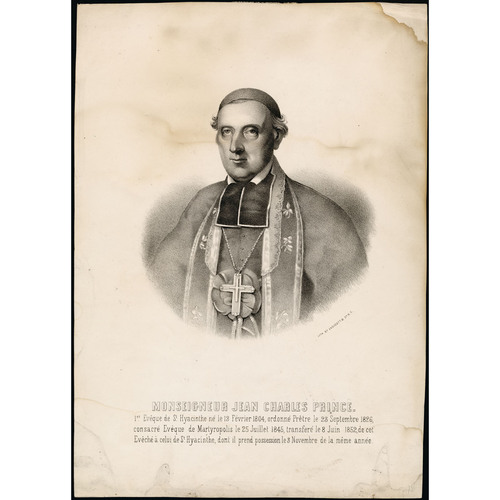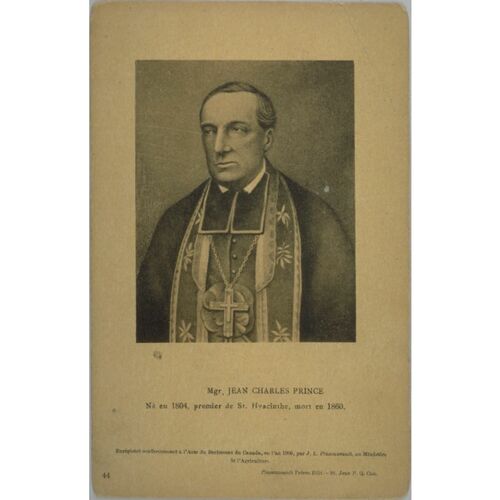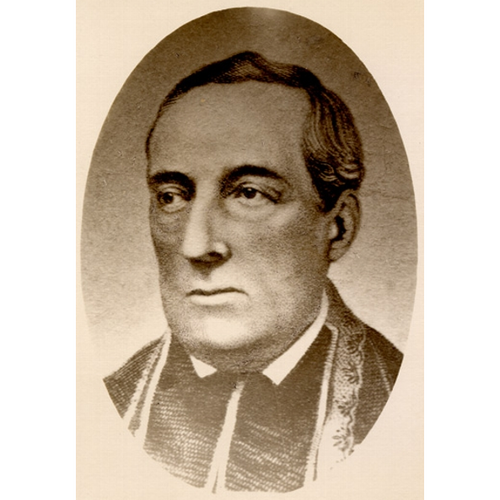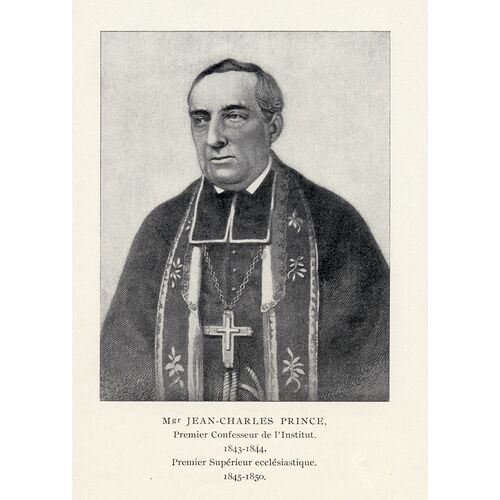PRINCE, JEAN-CHARLES, Roman Catholic priest, teacher, seminary administrator, editor, and bishop; b. 13 Feb. 1804 in Saint-Grégoire (Bécancour), Lower Canada, son of Jean Prince, a farmer, and Rosalie Bourg; d. 5 May 1860 in Saint-Hyacinthe, Lower Canada.
Jean-Charles Prince received his classical education at the Séminaire de Nicolet from 1813 to 1822. He began to study for the priesthood in 1822. In 1823–24, while taking theology courses as a seminarist, he taught rhetoric and the humanities. In the following school year he was made responsible for the teaching of philosophy at the Collège de Saint-Hyacinthe, and then in 1825 he returned to the Séminaire de Nicolet as a teacher of rhetoric. After his ordination on 23 Sept. 1826, Prince was summoned by Jean-Jacques Lartigue*, the auxiliary bishop in Montreal to the archbishop of Quebec, to assume various duties, including those of secretary to the bishop. He was also appointed chaplain of Saint-Jacques church.
In 1831, after six years in active association with Lartigue, Prince was made principal of the Collège de Saint-Hyacinthe (incorporated as the Séminaire de Saint-Hyacinthe in 1833). There, in 1825, he had formed strong ties of friendship with some of his pupils, in particular with Joseph La Rocque*, Joseph-Sabin Raymond*, and Isaac-Stanislas Lesieur-Désaulniers*, who were later called upon in turn to become superior of the seminary. When he arrived at the college, the new principal therefore found himself on familiar ground. His correspondence with Raymond in 1830 reveals how far Prince had accepted the ideas of Hugues-Félicité-Robert de La Mennais, and how fervently he had championed them with his young disciple.
From 1831 until Prince ceased to be principal in 1840, his life was closely linked to the institution for which he was responsible. As well as his primary office, he took on the duties of prefect of studies (1832–39), teacher of theology (1831–40), and procurator. According to the seminary’s principal historian, Canon Charles-Philippe Choquette*, during Prince’s term of office the classical college experienced a period of considerable expansion. Construction to enlarge and renovate the building was underway by 1832.
The college functioned in a social and political context which, added to its geographical location, was unlikely to protect it from the unrest related to the events of 1837–38. Thus the administration and staff of the college more than once found themselves caught in conflicts in which their behaviour prompted diverse interpretations concerning their political leanings, or at least what the government and ecclesiastical authorities thought to be such. Moreover, the college had in its student population sons, nephews, or cousins of such well-known Patriote leaders as Louis-Joseph Papineau*, Wolfred Nelson*, and Jean Dessaulles*; some of these leaders also had friends on its teaching staff. It was therefore no surprise that Prince and the college were closely watched by the government and ecclesiastical authorities and were more than once suspected or accused of being well disposed towards the Patriotes.
Certain events lent further credence to such rumours. For example, in August 1833 Papineau, the speaker of the House of Assembly and leader of the Patriote party, received an enthusiastic welcome from the pupils when he visited the college to see his son Lactance, who was then a boarder. The pro-Patriote papers, such as L’Écho du pays of Saint-Charles-sur-Richelieu, or the pro-government ones, such as L’Ami du peuple, de l’ordre et des lois of Montreal, had no intention of letting such an event go unnoticed, and the college found itself at the centre of a brief but heated controversy. This intensified a few weeks later after a visit by Governor Lord Aylmer [Whitworth-Aylmer*]. Aylmer, who had decided to attend the final examinations and the prize-giving, got a reception that some thought too cold in comparison to the far warmer one that had greeted Papineau. From then on, Prince was seen by the authorities at Quebec as a man tainted with partisan spirit, and was held in suspicion.
But it was difficult, if not impossible, to preserve real neutrality on the issues then dominating politics in Lower Canada. Prince and his staff had to deal tactfully with both the susceptibilities of the government and the nationalistic pride of some of the prominent Patriotes. If the former represented legitimate power, the latter none the less held enough of it to be able to make use of various forms of patronage. It was Papineau who was behind the grants that the college received from the government beginning in 1828, and it was through the support of Patriote representatives such as Louis Bourdages*, Édouard-Étienne Rodier*, and John Neilson* that the college obtained its incorporation in 1833. Hence, looking beyond the political leanings of its staff, the seminary could not ignore the manifold interests that linked it to the politicians of the Patriote party. Prince accordingly resigned himself to the suspicions and reproaches emanating from the archbishop of Quebec, Joseph Signay*, or the somewhat more cordial warnings from the bishop of Montreal, Lartigue, and his coadjutor, Ignace Bourget*. In a letter to Prince dated October 1837 Bourget urged, “Keep a close eye on your associates so far as their patriotic conduct is concerned. In this respect the institution is in a difficult situation.”
On 4 Nov. 1837 several priests from the parishes adjoining Saint-Hyacinthe met at the seminary and voiced their apprehension with regard to Lartigue’s pastoral letter of 24 October, which severely denounced any form of opposition to authority. Prince undertook to forward to his bishop a resolution expressing a desire that the clergy send an address to the government in London seeking justice for French Canadians, while affirming their own loyalty to the British crown. Lartigue supported the plan as much to satisfy the moderate Patriotes as to show that the clergy were not Papineau’s tool. Prince collected the necessary signatures and found himself heading a delegation to forward the petition to Archbishop Signay and Governor Lord Gosford [Acheson*]. Although the petition was abandoned at the beginning of December, Gosford having considered it untimely, it was replaced a few weeks later by another addressed this time to the queen, in which the loyalty of French Canadians after the insurrection was reaffirmed.
Immediately following the battles of Saint-Denis and Saint-Charles-sur-Richelieu, the Séminaire de Saint-Hyacinthe had to shelter for a few days 200 soldiers and six officers under the command of Colonel Charles Stephen Gore*. But at the same time the seminary was hiding within its walls two Patriote leaders on the run, Thomas Boutillier* and Pierre-Claude Boucher* de La Bruère. The soldiers were apparently treated with consideration by their hosts. “If that is what is needed to prove our loyalty,” wrote Prince, “then we are the most royalist people alive.” But this was not enough to protect the authorities of the seminary from suspicion and reproach. Prince was obliged to vindicate himself on many occasions, and to assert categorically that as far as the current political disputes were concerned his institution was entirely neutral. In February 1838 Prince, Raymond, and La Rocque even agreed to draft jointly a long “justificatory statement” to clear themselves from the suspicions weighing upon them concerning their political stance. The task was a difficult one and Bishop Bourget pointed out its magnitude in a letter to Prince, “You cannot imagine all the charges being levelled against your institution.”
Towards the end of 1838, although Prince was worried about the plight of the residents of Saint-Hyacinthe after the “looting” perpetrated by Major-General Sir James Macdonell’s troops, the seminary and its director appeared to be no longer the centre of controversy as far as the rebellions were concerned. The last two years of Prince’s term of office were, moreover, largely devoted to pedagogical changes and innovations. For example, he eliminated the long public examinations at year-end, encouraged the expansion of the seminary’s library, and in the same period equipped the physics laboratory with new apparatus.
In 1840 Bourget, who succeeded Lartigue as bishop of Montreal that year, decided to summon Prince to work with him. Among the numerous tasks the bishop proposed entrusting to him was the founding of a religious journal which would speak for the clergy and undertake to interpret contemporary ideas and events in the light of strict religious orthodoxy. This plan, which Lartigue had formulated in 1827, had of necessity been shelved after meeting stubborn resistance from the ecclesiastical authorities of Quebec. Bourget proposed in 1840 to give concrete form to a project that seemed as close to his heart as it had been to Lartigue’s. Hence the Mélanges religieux was founded. A prospectus for the newspaper was published on 21 Nov. 1840, announcing its objectives: “We will make religion the basis of all our teaching; we will apply ourselves mainly to enlightening the people about their duties.” Concerning secular matters of the day, particularly politics, the prospectus stated: “Despite their usefulness, it is felt that their place in a collection of this kind can be only a very secondary one.”
What the priest in charge of the Mélanges religieux did not divulge in public were his apprehensions about a task he considered too heavy to shoulder. He often unburdened himself on this subject in his correspondence with his former colleagues of the Séminaire de Saint-Hyacinthe, whom he pressed to contribute regularly to the paper. On 14 Dec. 1840 Prince began publishing in an unpretentious octavo edition a volume entitled Prémices des mélanges religieux. This publication, put out in seven parts concluding on 20 Jan. 1841, gave particular attention to reporting the public retreat preached at Montreal in December 1840 by Charles-Auguste-Marie-Joseph de Forbin-Janson*. Finally, on 22 Jan. 1841, the first issue of the Mélanges religieux came out. The paper was printed by Jacques-Alexis Plinguet and published under Prince’s direction, but it was learned later that the editorial team also included abbés Michael Power*, Antoine Manseau*, Hyacinthe Hudon*, and Jean-Baptiste Saint-Germain*. The publication of the newspaper was Prince’s responsibility until 10 Nov. 1843, when it changed hands.
The articles in the Mélanges religieux seldom disclosed the identities of their authors, who for the most part observed the strictest anonymity – a practice fairly common in mid-19th-century journalism. It is therefore difficult to identify Prince’s specific literary contribution in any precise way, although presumably it must have been considerable. It is even more certain that the ultramontane ideas the paper championed were entirely the responsibility of the person who directed it for almost three years. Through the medium of the Mélanges religieux, Prince was one of the advocates of that ideology in Lower Canada [see François-Xavier-Anselme Trudel*].
While in charge of the Mélanges religieux, Prince, who had become a canon of the cathedral chapter, also took on other duties entrusted to him by Bishop Bourget. For example, in 1841 he was appointed chaplain of the Montreal Asylum for Aged and Infirm Women, an establishment founded by a volunteer group of women, including Émilie Tavernier. Two years later he helped to train the novices who were to form the Daughters of Charity, Servants of the Poor. The bishop of Montreal had also in 1841 appointed him chief chaplain to the sisters of the Congregation of Notre-Dame and to the Religious Hospitallers of St Joseph of the Hôtel-Dieu in Montreal. He was given the added task of accompanying a contingent of the former community to Kingston, Upper Canada, at the request of the bishop there, Rémi Gaulin. Prince left for Kingston on 19 November and stayed a year. As well as helping the sisters to get settled and looking after preparations for the reception of a number of Religious Hospitallers of St Joseph, he ministered to the French Canadians of the region and studied English.
In 1842 Bourget, who seemed to value Prince’s help and efficiency, wrote to Rome requesting that he be appointed his coadjutor. Despite the opposition shown by the Sulpicians of Montreal, Bourget’s request was finally granted. On 5 July 1844 Prince was appointed bishop of Martyropolis and coadjutor to the bishop of Montreal. He was consecrated on 25 July 1845 by Bourget, assisted by Bishop Power and Bishop Pierre-Flavien Turgeon*.
As coadjutor, Prince was made responsible for managing the diocese of Montreal during Bourget’s second journey to Rome in 1846–47. He was sent there himself in October 1851, having been deputed by the first provincial council of Quebec to seek Pope Pius IX’s approval of the acts it had passed. The coadjutor of Montreal also conveyed the council’s request that two new dioceses, Saint-Hyacinthe and Trois-Rivières, be set up and that he be appointed to head the former. The appointment was confirmed on 8 June 1852, while Prince was still in Rome.
Bishop Prince assumed office on 3 Nov. 1852 upon returning home. He was to draw on the resources of the Séminaire de Saint-Hyacinthe frequently. Before the year was out he decided to appoint its superior, Raymond, his vicar general. A year later he acquired, apparently at a reasonable price, the building that had been known as “the old college” ever since the completion of the seminary’s second and larger building. Prince carefully transformed the old college into an episcopal palace and a cathedral chapel, but his purchase ended in tremendous disappointment on 17 May 1854 when the building was destroyed by a raging fire.
During his episcopacy Prince created a score of parishes and ordained 40 priests. Being concerned about the spiritual state of the Catholics who were dispersed among the Protestants of the Eastern Townships, he paid them frequent pastoral visits and opened several missions in the region. He also undertook to increase the number of teachers. While travelling in Europe he recruited members of the Sœurs de la Présentation de Marie to see to the education of girls. The sisters opened their first convent at Sainte-Marie-de-Monnoir (Marieville) in 1853, and at the time of Prince’s death were also running four more. In addition, he took steps to ensure that a community of Dominicans and teaching brothers was founded at Saint-Hyacinthe.
On 5 May 1860 Jean-Charles Prince, first bishop of Saint-Hyacinthe, died at the age of 56 as a result of a disease from which he had been suffering for several years.
ACAM, 295.101; 295.103; 901.078; RLB, I; RLL, IX. ANQ-MBF, CE1-30, 13 févr. 1804. Arch. de la chancellerie de l’évêché de Saint-Hyacinthe (Saint-Hyacinthe, Qué.), Reg. des lettres des évêques, sér.I, 1–3; VII.B.1; XIII.B.8, 1851–60. ASSH, A, B, Dossier 7; G; C, 1, Dossier 1.7; 2, Dossier 1.8; F, Fp-8. Mandements, lettres pastorales et circulaires des évêques de Saint-Hyacinthe, A.-X. Bernard, édit. (8v., Montréal, 1888–98), 1. Le Courrier de Saint-Hyacinthe, 11 mai 1860. Mélanges religieux, 21 nov. 1840 (prospectus); 14 déc. 1840–20 janv. 1841 (prémices); 22 janv., 19 nov., 3 déc. 1841; 14 janv. 1842. Allaire, Dictionnaire, 1: 450. Cécile Mondou, Inventaire sommaire d’une collection de mandements, lettres pastorales et circulaires de Mgr Jean-Charles Prince (P72), 1846–1886 (Montréal, 1979). Choquette, Hist. du séminaire de Saint-Hyacinthe, vol.1. Douville, Hist. du collège-séminaire de Nicolet, vol.2. Jacques Grisé, Les conciles provinciaux de Québec et l’Église canadienne (1851–1886) (Montréal, 1979). Lemieux, L’établissement de la première prov. eccl. [D.-A. Lemire-Marsolais, dite Sainte-Henriette et] Thérèse Lambert, dite Sainte-Marie-Médiatrice, Histoire de la Congrégation de Notre-Dame (11v. en 13 parus, Montréal, 1941– ). Pouliot, Mgr Bourget et son temps, vol.2. Henri D’Arles [M.-J.-H.-A. Beaudé], “Monseigneur Jean-Charles Prince,” BRH, 31 (1925): 467–68.
Cite This Article
Nadia Fahmy-Eid, “PRINCE, JEAN-CHARLES,” in Dictionary of Canadian Biography, vol. 8, University of Toronto/Université Laval, 2003–, accessed January 18, 2026, https://www.biographi.ca/en/bio/prince_jean_charles_8E.html.
The citation above shows the format for footnotes and endnotes according to the Chicago manual of style (16th edition). Information to be used in other citation formats:
| Permalink: | https://www.biographi.ca/en/bio/prince_jean_charles_8E.html |
| Author of Article: | Nadia Fahmy-Eid |
| Title of Article: | PRINCE, JEAN-CHARLES |
| Publication Name: | Dictionary of Canadian Biography, vol. 8 |
| Publisher: | University of Toronto/Université Laval |
| Year of publication: | 1985 |
| Year of revision: | 1985 |
| Access Date: | January 18, 2026 |


![Mgr Jean-Charles Prince, premier confesseur de l'Institut 1843- 1844. Premier Supérieur ecclésiastique. 1845-1850 [image fixe] Original title: Mgr Jean-Charles Prince, premier confesseur de l'Institut 1843- 1844. Premier Supérieur ecclésiastique. 1845-1850 [image fixe]](/bioimages/w600.8539.jpg)




